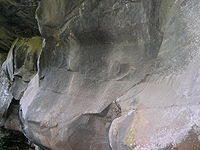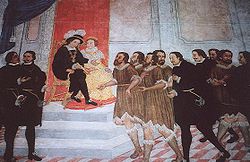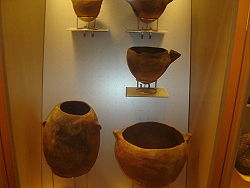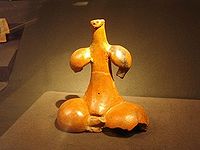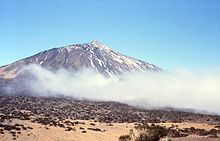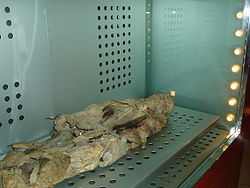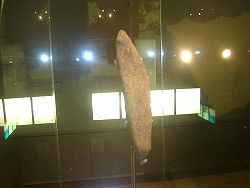- Guanches
-
Guanches
"man of Tenerife"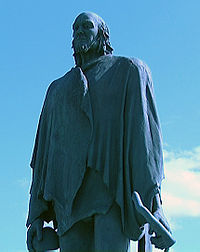
Statue of Bencomo at Candelaria, Tenerife Total population Unknown – Regions with significant populations  Canary Islands
Canary IslandsLanguages Guanche language · Silbo · Canarian Spanish
Religion Related ethnic groups Guanches (also: Guanchis or Guanchetos) is the name given to the aboriginal Berber inhabitants of the Canary Islands. It is believed that they migrated to the archipelago sometime between 1000 BCE and 100 BCE or perhaps earlier. While it is generally considered that the Guanches no longer exist as a distinct ethnicity,[1] traces of their culture can still be found, such as Silbo, the "whistled language" of La Gomera Island.
Contents
Etymology
The native term Guanchinet or Achinet literally translated means "person of Tenerife" (from Guan = person and Chinet = Tenerife).[1] It was modified, according to Juan Núñez de la Peña, by the Castilians into "Guanchos".[2]
Historical background
The Roman author and military officer, Pliny the Elder, drawing upon the accounts of Juba II, king of Mauretania, stated that a Mauretanian expedition to the islands around 50 BCE found the ruins of great buildings, but otherwise no population to speak of.[3] If this account is accurate, it may suggest that the Guanches were not the only inhabitants, or the first ones; or that the expedition simply did not explore the islands thoroughly.[citation needed]
Strictly speaking, the Guanches were the indigenous peoples of Tenerife, where the population seems to have lived in relative isolation up to the time of the Castilian conquest, around the 14th century (though Genoese, Portuguese, and Castilians may have visited there from the second half of the 8th century onwards). The name came to be applied to the original populations of Tenerife island.
Many Guanches died resisting the new colonizers, while others died from infectious diseases that accompanied the invaders, diseases to which the Guanches, because of their long isolation, had little immunity.
What remains of their language, Guanche—a few expressions, vocabulary words and the proper names of ancient chieftains still borne by certain families—exhibits positive similarities with the Berber languages.[4][5] The first reliable account of Guanche language was provided by the Genoese explorer Nicoloso da Recco in 1341, with a translation of numbers used by the islanders.
Petroglyphs attributed to various Mediterranean civilizations have been found on some of the islands. In 1752, Domingo Vandewalle, a military governor of Las Palmas, attempted to investigate them, and Aquilino Padron, a priest at Las Palmas, catalogued inscriptions at El Julan, La Candía and La Caleta on El Hierro. In 1878 Dr. R. Verneau discovered rock carvings in the ravines of Las Balos that resemble Libyan or Numidic writing from the time of Roman occupation or earlier. In other locations, Libyco-Berber script has been identified. However, according to European chroniclers, the Guanches did not possess a system of writing at the time of conquest.
First Arab explorer
Main article: Canary Islands in pre-colonial timesThe geographic accounts of Pliny the Elder and of Strabo mention the Fortunate Isles but do not report anything about their populations. Accounts about the Guanche population were first made around 1150 CE by the Arab geographer Muhammad al-Idrisi in the Nuzhatul Mushtaq, a book he wrote for King Roger II of Sicily, in which al-Idrisi reports a journey in the Atlantic Ocean made by the Mugharrarin ("the adventurers"), a family of Andalusian seafarers from Lisbon, Portugal. The only surviving version of this book, kept at the Bibliothèque Nationale de France, and first translated by Pierre Amédée Jaubert, reports that, after having reached an area of "sticky and stinking waters" (probably the Sargasso Sea), the Mugharrarin moved back and first reached an uninhabited Island (Madeira or Hierro), where they found "a huge quantity of sheeps the meat of which was bitter and uneatable" and, then, "continued southward" and reached another island where they were soon surrounded by barks and brought to "a village whose inhabitants were often fair hair with long and flaxen hair and the women of a rare beauty". Among the villagers, one did speak Arabic and asked them where they came from. Then the king of the village ordered them to bring them back to the continent where they were surprised to be welcomed by Berbers.[6] Apart from the marvelous and fanciful content of this history, this account would suggest that Guanches had sporadic contacts with populations from the mainland.
During the 14th century, the Guanches are presumed to have had other contacts with Balearic seafarers from Spain, suggested by the presence of Balearic artefacts found on several of the Canary Islands[citation needed].
Hispanic invasion
Main article: Invasion of the Canary IslandsAlonso Fernández de Lugo presenting the captured Guanche kings of Tenerife to Ferdinand and Isabella.
The Spanish invasion of the islands began in 1402, with the expedition of Jean de Béthencourt and Gadifer de la Salle to the island of Lanzarote. Gadifer would invade Lanzarote and Fuerteventura with ease since many of the aborigines, faced with issues of starvation and poor agriculture, would surrender to Castilian rule.
The other five islands fought back. El Hierro and the Bimbache population were the next to fall, then La Gomera, Gran Canaria, La Palma and in 1496, Tenerife.
Tenerife was most successful against the Castilian invaders. In the First Battle of Acentejo (31 May 1494), called La Matanza or "The Slaughter," Guanches ambushed the Castilians in a valley and killed many. Only one in five of the Castilians survived, including the leader of the expedition, Alonso Fernandez de Lugo.
Lugo would return later to the island with the alliance of the kings of the southern part of the island, and defeated the Guanches in the Battle of Aguere. The northern Menceyatos or provinces fell after the Second Battle of Acentejo with the defeat of the successor of Bencomo, Bentor, Mencey of Taoro – what is now the Orotava Valley – in 1496.
Origins
Genetic evidence shows that northern African peoples (most likely descendants of the Capsian culture) made a significant contribution to the aboriginal population of the Canaries following desertification of the Sahara at some point after 6000 BC. Linguistic evidence suggests ties between the Guanche language and the Berber languages of northern Africa, particularly when comparing numeral systems.[5][7] Research into the genetics of the Guanche population have led to the conclusion that they share an ancestry with Berber peoples.[8]
The islands were visited by a number of peoples within recorded history. The Numidians, Phoenicians, and Carthaginians knew of the islands and made frequent visits,[9] including expeditions dispatched from Mogador by Juba.[10] The Romans occupied northern Africa and visited the Canaries between the 1st and 4th centuries CE, judging from Roman artefacts found on the island of Lanzarote. These show that Romans did trade with the Canaries, though there is no evidence of their ever settling there.[11] Archaeology of the Canaries seem to reflect diverse levels of technology, some differing from the Neolithic culture that was encountered at the time of conquest.
It is thought that the arrival of the aborigines to the archipelago led to the extinction of some big reptiles and insular mammals, for example, the giant lizard Gallotia goliath (which managed to reach up to a meter in length) and Canariomys bravoi, the giant rat of Tenerife.
Population genetics
A 2003 genetics research article by Nicole Maca-Meyer et al. published in the European Journal of Human Genetics compared aboriginal Guanche mtDNA (collected from Canarian archaeological sites) to that of today's Canarians and concluded that, "despite the continuous changes suffered by the population (Spanish colonisation, slave trade), aboriginal mtDNA [direct maternal] lineages constitute a considerable proportion [42 – 73%] of the Canarian gene pool. Although the Berbers are the most probable ancestors of the Guanches, it is deduced that important human movements [e.g., the Islamic-Arabic conquest of the Berbers] have reshaped Northwest Africa after the migratory wave to the Canary Islands" and the "results support, from a maternal perspective, the supposition that since the end of the 16th century, at least, two-thirds of the Canarian population had an indigenous substrate, as was previously inferred from historical and anthropological data."[8] mtDNA haplogroup U subclade U6b1 is Canarian-specific[12] and is the most common mtDNA haplogroup found in aboriginal Guanche archaeological burial sites.[8]
Both the study done by Maca-Meyer et al. (2003) on Tenerife aborigines and the study done by Fregel et al. (2009) on La Palma aborigines found the majority of mt-DNA haplogroups belonging to the Eurasian clades such as H/HV/U*/R. The study done by Maca-Meyer et al. (2003) on Tenerife Aborigines used a total sample of 71 aborigines and found that the frequency of the Cambridge Reference Sequence Cambridge Reference Sequence(CRS) which belongs to the European haplogroup H2a2 was 21.12% of the total sample. Meanwhile the same study Maca-Meyer et al.(2003)found out that frequencies of haplogroups H/HV/U*/R(-CRS) at 30.98% of the total; also mtDNA haplogroup V was observed at frequencies of 4.23% of the total sample."[13]
Y-DNA, or Y-chromosomal, (direct paternal) lineages were not analyzed in this study; however, an earlier study giving the aboriginal y-DNA contribution at 6% was cited by Maca-Meyer et al., but the results were criticized as possibly flawed due to the widespread phylogeography of y-DNA haplogroup E1b1b1b, which may skew determination of the aboriginality versus coloniality of contemporary y-DNA lineages in the Canaries. Regardless, Maca-Meyer et al. states that historical evidence does support the explanation of "strong sexual asymmetry...as a result of a strong bias favoring matings between European males and aboriginal females, and to the important aboriginal male mortality during the Conquest."[13] The genetics thus suggests the native men were sharply reduced in numbers due to the war, large numbers of Spaniard men stayed in the islands and married the local women, the Canarians adopted Spanish names, language, and religion, and in this way, the Canarians were Hispanicized.
According to a recent study by Fregel et al. 2009, in spite of the geographic nearness between the Canary Islands and Morocco, the genetic heritage of the Canary islands male lineages, is mainly from European origin. Indeed, nearly 67% of the haplogroups resulting from are Euro–Eurasian (R1a(2.76%), R1b (50.62%), I (9.66%) and G (3.99%)). Unsurprisingly the Spanish conquest brought the genetic base of the current male population of the Canary Islands. Nevertheless, the second most important Haplogroup family is from Northern Africa, Near and Middle East. E1b1b (14% including 8.30% of the typical berber haplogroup E-M81), E1b1a and E1a (1.50%), J (14%) and T (3%) Haplogroups are present at a rate of 33%. Even if a part of these "eastern" haplogroups were introduced by the Spanish too, we can suppose that a good portion of this rate was already there at the time of the conquest.[14][15] According to this same study the presence of autochthonous North African E-M81 lineages, and also other relatively abundant markers (E-M78 and J-M267) from the same region in the indigenous Guanche population, "strongly points to that area [North Africa] as the most probable origin of the Guanche ancestors". In this study, Fregel et al. estimated that, based on Y-chromosome and mtDNA haplogroup frequencies, the relative female and male indigenous Guanche contributions to the present-day Canary Islands populations was respectively of 41.8% and 16.1%.[16]
An autosomal study in 2011 found an average Northwest African influence of about 17% in Canary Islanders with a wide interindividual variation ranging from 0% to 96%. According to the authors, the substantial Northwest African ancestry found for Canary Islanders supports that, despite the aggressive conquest by the Spanish in the 15th century and the subsequent immigration, genetic footprints of the first settlers of the Canary Islands persist in the current inhabitants. Paralleling mtDNA findings, the largest average Northwest African contribution was found for the samples from La Gomera. [17]
Canary Islands N Average NW African ancestry La Gomera 7 42.50% Fuerteventura 10 21.60% La Palma 7 21.00% El Hierro 7 19.80% Lanzarote 13 16.40% Tenerife 30 14.30% Gran Canaria 30 12.40% Total Canary Islanders 104 17.40% Canary Islands/NW African mtDna N %U6 %L Total Study La Gomera 46 50.01% 10.86% 60.87% Fregel 2009[18] El Hierro 32 21.88% 12.49% 34.37% Fregel 2009 Lanzarote 49 20.40% 8.16% 28.56% Fregel 2009 Gran Canaria 80 11.25% 10% 21.25% Fregel 2009 Tenerife 174 12.09% 7.45% 19.54% Fregel 2009 La Palma 68 17.65% 1.47% 19.12% Fregel 2009 Fuerteventura 42 16.66% 2.38% 19.04% Fregel 2009 System of beliefs
Religion and mythology
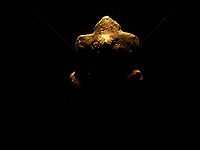 Guatimac idol in the Archaeological Museum of Puerto de la Cruz (Tenerife).
Guatimac idol in the Archaeological Museum of Puerto de la Cruz (Tenerife).
Little is known of the religion of the Guanches. There was a general belief in a supreme being, called Achamán in Tenerife, Acoran in Gran Canaria, Eraoranhan in Hierro, and Abora in La Palma. The women of Hierro worshipped a goddess called Moneiba. According to tradition, the male and female gods lived in mountains, from which they descended to hear the prayers of the people. On other islands, the natives venerated the sun, moon, earth and stars. A belief in an evil spirit was general. The demon of Tenerife was called Guayota and lived at the peak of Teide volcano, which was the hell called Echeyde; in Tenerife and Gran Canaria, the minor demons took the form of wild black woolly dogs called Tibicenas, which lived in deep caves of the mountains, emerging at night to attack livestock and human beings.[citation needed]
In Tenerife Magec (god of the Sun) and Chaxiraxi (the goddess mother) were also worshiped. In times of drought, the Guanches drove their flocks to consecrated grounds, where the lambs were separated from their mothers in the belief that their plaintive bleating would melt the heart of the Great Spirit. During the religious feasts, hostilities were held in abeyance, from war to personal quarrels.
Idols found in the islands, including the Idol of Tara (Museo Canario, Las Palmas de Gran Canaria) and The Guatimac (Museum Archaeological of Puerto de la Cruz in Tenerife). But they also have found many more figures in the rest of the archipelago.
Most researchers agree that the Guanches performing their worship in the open, under sacred trees such as pine or drago, or near sacred mountains such as Mount Teide, which was believed Guayota the abode of the devil . Mount Teide was sacred to the aboriginal Guanches and since 2007 is a World Heritage Site. But sometimes the Guanches also performed worship in caves, as in "Cave of Achbinico" in Tenerife, where he was worshiping the Virgin of Candelaria (Patron of Canary Islands). Until the 20th century, there were in the Canary Islands (especially in northern Tenerife) individuals called "Animeros". They were similar to healers and mystics with a syncretic belief among the Guanches Berber religion and Christianity. As in other countries close to the islands (e.g. marabouts from the Maghreb), the Animeros were considered "persons blessed by God".[19]
Principal gods of Tenerife God Role Achamán The supreme god of the Guanches on the island of Tenerife; he is the father god and creator. Chaxiraxi The native goddess known as the Sun Mother. Chijoraji A divine child, son of Chaxiraxi. Chijoragi Magec The god of the Sun and the light and also thought to be one of the principal divinities. Achuguayo God of the moon. It was the duality of Magec god (god of the sun). Achuhucanac Rain god, identified with the supreme god (Achamán). Guayota The principal malignant deity and Achamán's adversary. Mythical beings Being Role Maxios Benevolent minor gods or genies; domestic spirits and guardians of specific places. Tibicenas Demons in the form of black dogs, these were children of Guayota, the malignant deity. Aboriginal priests
The Guanches had priests or shamans who were connected with the gods and ordained hierarchically:
Religious authority Jurisdiction Definition Guadameñe or Guañameñe Tenerife spiritual advisers to the Menceyes (Aboriginal kings), who directed the worship. Faykan or Faicán Gran Canaria a spiritual and religious person in charge, who directed the worship. Maguadas or Arimaguadas - Tenerife
- Gran Canaria
women priestesses dedicated to worship. They took part in some rituals. Kankus Tenerife the priests responsible for the worship of the ancestor spirits and Maxios (minor gods or genies). Guatimac
Main article: GuatimacFestivities
Beñesmer the festival was a festival of the agricultural calendar of the Guanches (the new year Guanche) to be held after the gathering of crops devoted to Chaxiraxi (on August 15). In this event the Guanches shared milk, gofio, sheep or goat meat (food good prices for Guanches). At the present time coincides with the pilgrimage to the Basilica of the Virgin of Candelaria (Patron of Canary Islands).
Among the cultural events are significant traces of aboriginal traditions at the holidays and in the current Romería Relief in Güímar (Tenerife) and the lowering of the Rama, in Agaete (Gran Canaria).[20]
Funerals and mummies
Main article: Guanche mummiesMummification was practiced throughout the islands and was highly developed on Tenerife in particular. In La Palma, the elderly were left to die alone at their own wish. After bidding their family farewell, they were carried to the sepulchral cave, with nothing but a bowl of milk being left to them. The Guanches embalmed their dead; many mummies have been found in an extreme state of desiccation, each weighing not more than 6 or 7 pounds. Two almost inaccessible caves in a vertical rock by the shore 3 miles from Santa Cruz on Tenerife are said still to contain remains. The process of embalming seems to have varied. In Tenerife and Gran Canaria, the corpse was simply wrapped up in goat and sheep skins, while in other islands a resinous substance was used to preserve the body, which was then placed in a cave difficult to access, or buried under a tumulus. The work of embalming was reserved for a special class, with women tending to female corpses, and men for the male ones. Embalming seems not to have been universal, and bodies were often simply hidden in caves or buried.
In the Museo de la Naturaleza y el Hombre (Santa Cruz de Tenerife) mummies of original inhabitants of the Canary Islands are displayed.
In 1933, the largest Guanche necropolis of the Canary Islands was found, at Uchova in the municipality of San Miguel de Abona in the south of the island of Tenerife. This cemetery was almost completely looted; it is estimated to have contained between 60 and 74 mummies.[21]
Political system
The political and social institutions of the Guanches varied. In some islands like Gran Canaria hereditary autocracy by matrilineality prevailed; in others the government was elective. In Tenerife all the land belonged to the kings who leased it to their subjects. In Gran Canaria, suicide was regarded as honourable, and whenever a new king was installed, one of his subjects willingly honoured the occasion by throwing himself over a precipice.[1][22] In some islands, polyandry was practised; in others they were monogamous. Insult of a woman by an armed man was allegedly a capital offense.[23]
The island of Tenerife was divided into nine small kingdoms (menceyatos), each ruled by a king or Mencey. The Mencey was the ultimate ruler of the kingdom, and at times, meetings were held between the various kings. When the Castilians invaded the Canary Islands, the southern kingdoms joined the Castilian invaders on the promise of the richer lands of the north; the Castilians betrayed them after ultimately securing victory at the Battles of Aguere and Acentejo.
Kings (Menceys) of Tenerife
- Acaimo or Acaymo (Menceyato of Tacoronte).
- Adjona: (Menceyato of Abona).
- Añaterve: (Menceyato of Güímar).
- Bencomo: (Menceyato of Taoro).
- Beneharo: (Menceyato of Anaga).
- Pelicar: (Menceyato of Adeje).
- Pelinor: (Menceyato of Icode).
- Romen: (Menceyato of Daute).
- Tegueste: (Menceyato of Tegueste).
In Tenerife the grand Mencey Tinerfe and his father Sunta Mencey governed the unified island, which afterwards was divided into nine kingdoms by the children of Tinerfe.
Clothes and weapons
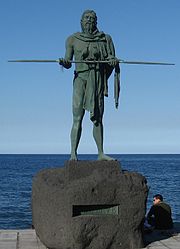 A statue of the Guanche mencey Añaterve. Candelaria, Tenerife.
A statue of the Guanche mencey Añaterve. Candelaria, Tenerife.
Guanches wore garments made from goat skins or woven from plant fibers, which have been found in the tombs of Tenerife. They had a taste for ornaments and necklaces of wood, bone and shells, worked in different designs. Beads of baked earth, cylindrical and of all shapes, with smooth or polished surfaces, mostly colored black and red, were fairly common. Dr. René Verneau suggested that the objects the Castilians referred to as pintaderas, baked clay seal-shaped objects, were used as vessels for painting the body in various colours. They manufactured rough pottery, mostly without decorations, or ornamented by making fingernail indentations.
Guanche weapons adapted to the insular environment (using wood, obsidian and stone as primary materials), with later influences from medieval European weaponry. Basic armaments in several of the islands included javelins of 1 to 2 m in length (known as Banot on Tenerife); round, polished stones; spears; maces (common in Gran Canaria and Tenerife, and known as Magado and Sunta, respectively); and shields (small in Tenerife and human-sized in Gran Canaria, where they were known as Tarja, made of Drago wood and painted with geometric shapes). After the arrival of the Europeans, Guanche nobility from Gran Canaria were known to wield large wooden swords (larger than the European two-handed type) called Magido, which were said to be very effective against both infantrymen and cavalry. Weaponry made of wood was hardened with fire. These armaments were commonly complemented with a stone or obsidian knife known as a Tabona.
Dwellings were situated in natural or artificial caves in the mountains. In areas where cave dwellings were not feasible, they built small round houses and, according to the Castilians, practiced crude fortification.
Presumed Guanche names of the Canary Islands Spanish Guanche Tenerife Achinech Achineche Asensen La Gomera Gomera Gomahara. La Palma Benahoare El Hierro Eseró Heró Gran Canaria Tamaran Lanzarote Titerogakaet Titeroigatra Fuerteventura Maxorata Erbania Erbani Museums
Many of the museums island islands in their collections of archaeological material and human remains from prehistory and history archipelago of the Canaries. Some of the most important are:
- Museo de la Naturaleza y el Hombre (Santa Cruz de Tenerife).
- Museo Canario (Las Palmas de Gran Canaria).
- Museo de Historia y Antropología de Tenerife (Casa Lercaro, San Cristóbal de La Laguna, Tenerife).
- Museo Arqueológico del Puerto de La Cruz (Puerto de la Cruz, Tenerife).
New religious movement
In 2001, the Church of the Guanche People (Iglesia del Pueblo Guanche), a Neopagan movement with several hundred followers, was founded in San Cristóbal de La Laguna (Tenerife).[24] [25]
Guanche people
See also
- Guanche language
- Hamitic
- Silbo – a Guanche whistling language, still alive
- Isleños
- First Battle of Acentejo
- Battle of Aguere
- Second Battle of Acentejo
- Teide
- Achinet
- Animero
Notes
- ^ a b c "Section 14". The Encyclopaedia Britannica: A Dictionary of Arts, Sciences, Literature and General Information. Encyclopaedia Britannica. 1910. pp. 650.
- ^ (in Castilian) Conquista y antigüedades de las islas de la Gran Canaria y su descripción, con muchas advertencias de sus privilegios, conquistadores, pobladores y otras particularidades en la muy poderosa isla de Tenerife, dirigido a la milagrosa imagen de Nuestra Señora de Candelaria.
- ^ Pliny, "Natural History" Bk 6 ch 37
- ^ Andrew Dalby, Dictionary of Languages, 1998, p. 88 "Guanche, indigenous language of the Canary Islands, is generally thought to have been a Berber language."
- ^ a b Bynon J., "The contribution of linguistics to history in the field of Berber studies." In: Dalby D, (editor) Language and history in Africa New York: Africana Publishing Corporation, 1970, p 64–77.
- ^ Idrisi, La première géographie de l'Occident, NEF, pARIS 1999
- ^ Andrew Dalby, Dictionary of Languages, 1998, p. 88
- ^ a b c Maca-Meyer N, Arnay M, Rando JC, et al. (February 2004). "Ancient mtDNA analysis and the origin of the Guanches". Eur. J. Hum. Genet. 12 (2): 155–62. doi:10.1038/sj.ejhg.5201075. PMID 14508507. http://www.nature.com/ejhg/journal/v12/n2/full/5201075a.html.
- ^ Galindo, Juan de Abreu. "VII". The History of the Discovery and Conquest of the Canary Islands. Adamant Media Corporation. pp. 173. ISBN 1-4021-7269-9.
- ^ C.Michael Hogan, Mogador: promontory fort, The Megalithic Portal, ed. Andy Burnham, Nov. 2, 2007 [1]
- ^ Andrew L. Slayman, "Roman Trade With the Canary Islands", Archeology Newsbriefs, A publication of the Archaeological Institute of America, Volume 50 Number 3, May/June 1997 [2]
- ^ Pereira L, Macaulay V, Prata MJ, Amorim A (January 2003). "Phylogeny of the mtDNA haplogroup U6. Analysis of the sequences observed in North Africa and Iberia". Progress in Forensic Genetics 9. Proceedings from the 19th. 1239. pp. 491–3. doi:10.1016/S0531-5131(02)00553-8. http://www.sciencedirect.com/science?_ob=ArticleURL&_udi=B7581-47W664D-1JF&_user=10&_rdoc=1&_fmt=&_orig=search&_sort=d&view=c&_acct=C000050221&_version=1&_urlVersion=0&_userid=10&md5=365d5674ca70b3ac4a6f0522140ec294.
- ^ a b http://www.nature.com/ejhg/journal/v12/n2/full/5201075a.html Ancient mtDNA analysis and the origin of the Guanches.
- ^ Fregel et al. 2009, Demographic history of Canary Islands male gene-pool: replacement of native lineages by European, see table
- ^ Zurita AI, Hernandez A, Sanchez JJ, Cuellas JA (March 2005). "Y-chromosome STR haplotypes in the Canary Islands population (Spain)". Forensic Science International 148 (2-3): 233–8. doi:10.1016/j.forsciint.2004.05.004. PMID 15639620.
- ^ Fregel et al. 2009,see table
- ^ Pino-Yanes M, Corrales A, Basaldúa S, Hernández A, Guerra L, et al. 2011 North African Influences and Potential Bias in Case-Control Association Studies in the Spanish Population. PLoS ONE 6(3): e18389. doi:10.1371/journal.pone.0018389
- ^ Fregel et al.(2009) The maternal aborigine colonization of La Palma (Canary Islands) Euro J Hum Gen 17:1314-1324
- ^ Animeros en Canarias - in spanish
- ^ 1
- ^ Un estudio recuerda el expolio de la mayor necrópolis guanche jamás hallada
- ^ Aliño, López-Ibor; Carmen Leal Cercós, arlos Carbonell Masiá, Janssen-Cilag. Images of Spanish Psychiatry. World Psychiatric Association. Editorial Glosa, S.L.. pp. 574. ISBN 8-4742-9200-X.
- ^ "Guanches". 1911encyclopedia.org. http://www.1911encyclopedia.org/Guanches. Retrieved 2008-09-17.
- ^ (Spanish)Minorías religiosas en Canarias
- ^ (Spanish)laopinion on religious minorities in the Canaries´
References
 This article incorporates text from a publication now in the public domain: Chisholm, Hugh, ed (1911). Encyclopædia Britannica (11th ed.). Cambridge University Press.
This article incorporates text from a publication now in the public domain: Chisholm, Hugh, ed (1911). Encyclopædia Britannica (11th ed.). Cambridge University Press.- Alfred W. Crosby, Ecological Imperialism: The Biological Expansion of Europe, 900–1900, 1993
- John Mercer, The Canary Islanders: Their History, Conquest & Survival, 1980
- Mitochondrial DNA transit between West Asia and North Africa inferred from U6 phylogeography
- Roman Trade With the Canary Islands, Archaeology 50.3 (1997)
- The Voyages of Christopher Columbus
- E. G. Bourne, ed., The Northmen, Columbus and Cabot (New York, 1906).
- Wikipedia page in Spanish.
- Piedra Zanata
External links
History Guanches · Pre-colonial times · Treaty of Alcáçovas · First Battle of Acentejo · Battle of Aguere · Second Battle of Acentejo · Battle of Santa Cruz de Tenerife (1657) · Battle of Santa Cruz de Tenerife (1797) · Spanish transition · Autonomous communityLanguages Mythology Sports Bola canaria · Canarian wrestling · Juego del Palo · Salto del pastor · Open Lanzarote Island · Open Costa AdejeCuisine Almogrote · Canarian arepa · Canarian wrinkly potatoes · Gofio · Malvasia · Majorero · Miel de palma · Mojo · Pasteles · Ropa vieja · Sancocho · Sangria · Tropical beer · WinesMusical instruments Traditions Carnival of Santa Cruz de Tenerife · Carnival of Las Palmas · Bajada (festival) · Cavalcade of Magi · Holy Week · Virgin of Candelaria · Cristo de La Laguna · AkelarreSymbols places of the Canary Islands Category
Wikimedia Foundation. 2010.

